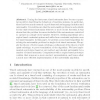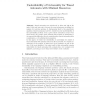106
Voted
ASYNC
2005
IEEE
15 years 6 months ago
2005
IEEE
We propose a novel technique for modeling and verifying timed circuits based on the notion of generalized relative timing. Generalized relative timing constraints can express not ...
103
Voted
IPPS
2006
IEEE
15 years 6 months ago
2006
IEEE
We show that timed automata can be used to model and to analyze timeliness properties of embedded system architectures. Using a case study inspired by industrial practice, we pres...
104
Voted
GPCE
2007
Springer
15 years 6 months ago
2007
Springer
In this paper, we propose a domain-specific aspect language to prevent the denials of service caused by resource management. Our aspects specify availability policies by enforcin...
FSEN
2007
Springer
15 years 6 months ago
2007
Springer
Abstract. During the last years, timed automata have become a popular model for describing the behaviour of real-time systems. In particular, there has been much research on proble...
FORMATS
2007
Springer
15 years 6 months ago
2007
Springer
Timed automata were introduced by Alur and Dill in the early 1990s and have since become the most prominent modelling formalism for real-time systems. A fundamental limit to the al...
118
Voted
ASWEC
2007
IEEE
15 years 6 months ago
2007
IEEE
Behavior Trees (BTs) are a graphical notation used for formalising functional requirements and have been successfully applied to several case studies. However, the notation curren...
110
Voted
QEST
2008
IEEE
15 years 6 months ago
2008
IEEE
In [3] a probabilistic semantics for timed automata has been defined in order to rule out unlikely (sequences of) events. The qualitative model-checking problem for LTL propertie...
140
Voted
SACMAT
2009
ACM
15 years 7 months ago
2009
ACM
An access control system is often viewed as a state transition system. Given a set of access control policies, a general safety requirement in such a system is to determine whethe...
FSEN
2009
Springer
15 years 7 months ago
2009
Springer
We present an automata theoretic framework for modular schedulability analysis of real time asynchronous objects modeled in the language Creol. In previous work we analyzed the sch...
FORMATS
2009
Springer
15 years 7 months ago
2009
Springer
In this paper, we focus on the synthesis of secure timed systems which are given by timed automata. The security property that the system must satisfy is a non-interference propert...


